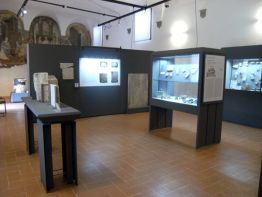Il Museo Archeologico Statale di Spoleto è situato all’interno del complesso monumentale, ex monastero di S. Agata; il museo conserva le prime tracce della presenza di una civiltà all’interno dell’area della rocca e del centro storico, risalenti all’età del bronzo.
Le testimonianze ed i reperti archeologici, tra cui terrecotte e produzioni ceramiche, sono conservate all’interno dell’area espositiva del museo; rivestono particolare importanza i due cippi che riportano la “lex luci spoletina”, in latino arcaico, la quale stabilisce sanzioni contro eventuali profanazioni del bosco consacrato a Giove.
Al secondo piano del Museo sono esposti alcuni reperti provenienti dalla zona della Valnerina, tra cui i cinerari dell’età del bronzo finale dalla necropoli di Monteleone di Spoleto, i reperti dai santuari di Monteleone di Spoleto e di Montefranco, i corredi funebri dalla necropoli ellenistica e romana di Norcia.
Orari di apertura
8,30 – 19,30 chiuso il lunedì mattina
The State Archaeological Museum of Spoleto is located within the monument, the former monastery of S. Agatha, the museum houses the first traces of a civilizationin the area of the castle and old town, dating from the Bronze Age.
The evidence and the archaeological finds, including pottery and ceramicsproduction, are preserved in the exhibition of the museum are of particularimportance are the two stones that bear the “lex luci spoletina” in archaic Latin, which provides for sanctions against any desecration of wood consecrated to Jupiter.
On the second floor of the museum are items excavated from the area of the Nera Valley, including the final Bronze Age urns from the necropolis of Monteleone diSpoleto, the finds from the sanctuaries of Monteleone di Spoleto and Montefranco, funeral from the Hellenistic necropolis and Roman city of Norcia.
Opening Hours
8.30 to 19.30 Closed on Monday morning
The State Archaeological Museum of Spoleto is located within the monument, the former monastery of S. Agatha, the museum houses the first traces of a civilizationin the area of the castle and old town, dating from the Bronze Age.
The evidence and the archaeological finds, including pottery and ceramicsproduction, are preserved in the exhibition of the museum are of particularimportance are the two stones that bear the “lex luci spoletina” in archaic Latin, which provides for sanctions against any desecration of wood consecrated to Jupiter.
On the second floor of the museum are items excavated from the area of the Nera Valley, including the final Bronze Age urns from the necropolis of Monteleone diSpoleto, the finds from the sanctuaries of Monteleone di Spoleto and Montefranco, funeral from the Hellenistic necropolis and Roman city of Norcia.
Opening Hours
8.30 to 19.30 Closed on Monday morning
The State Archaeological Museum of Spoleto is located within the monument, the former monastery of S. Agatha, the museum houses the first traces of a civilizationin the area of the castle and old town, dating from the Bronze Age.
The evidence and the archaeological finds, including pottery and ceramicsproduction, are preserved in the exhibition of the museum are of particularimportance are the two stones that bear the “lex luci spoletina” in archaic Latin, which provides for sanctions against any desecration of wood consecrated to Jupiter.
On the second floor of the museum are items excavated from the area of the Nera Valley, including the final Bronze Age urns from the necropolis of Monteleone diSpoleto, the finds from the sanctuaries of Monteleone di Spoleto and Montefranco, funeral from the Hellenistic necropolis and Roman city of Norcia.
Opening Hours
8.30 to 19.30 Closed on Monday morning
The State Archaeological Museum of Spoleto is located within the monument, the former monastery of S. Agatha, the museum houses the first traces of a civilizationin the area of the castle and old town, dating from the Bronze Age.
The evidence and the archaeological finds, including pottery and ceramicsproduction, are preserved in the exhibition of the museum are of particularimportance are the two stones that bear the “lex luci spoletina” in archaic Latin, which provides for sanctions against any desecration of wood consecrated to Jupiter.
On the second floor of the museum are items excavated from the area of the Nera Valley, including the final Bronze Age urns from the necropolis of Monteleone diSpoleto, the finds from the sanctuaries of Monteleone di Spoleto and Montefranco, funeral from the Hellenistic necropolis and Roman city of Norcia.
Opening Hours
8.30 to 19.30 Closed on Monday morning


Comment (0)